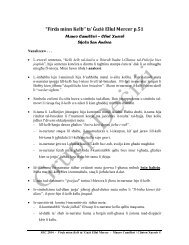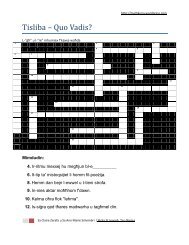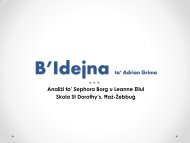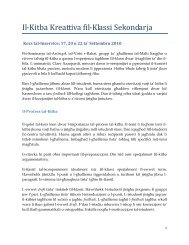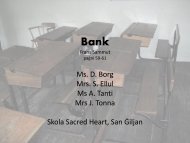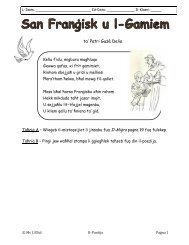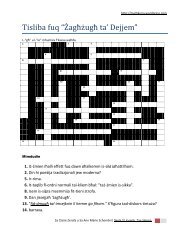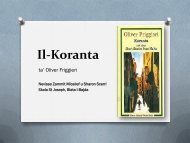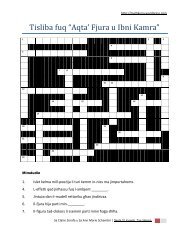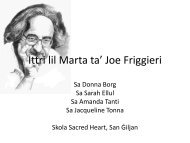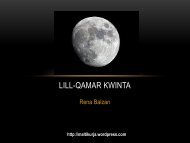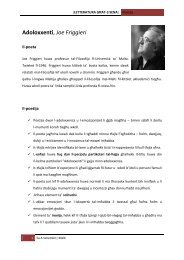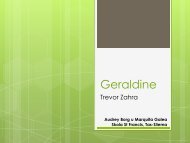Analiżi â Katrin tal-Imdina
Analiżi â Katrin tal-Imdina
Analiżi â Katrin tal-Imdina
- No tags were found...
You also want an ePaper? Increase the reach of your titles
YUMPU automatically turns print PDFs into web optimized ePapers that Google loves.
Il-Kontenut “Il-motiv storiku, il-kontenut imnikket, il-kuntrast aħraxbejn il-festiv u l-eleġajku, is-sentimenti tas-solidarjeta’nazzjonali kontra l-aggressjoni <strong>tal</strong>-barrani blatwemmin; kollox huwa mwaħħad f’innu popolari lijiċċelebra l-innoċenza <strong>tal</strong>-Maltin u jikkundannamingħajr ma jtenni kelma waħda ta’ vendetta fuql-azzjoni <strong>tal</strong>-għadu.” Oliver FriggieriMarquita Galea u Audrey Borg
JOINT FOREWORDThe first model local Memorandum of Understanding [MoU] was published jointly by ADCS andADASS in December 2009 2 . A summary version was prepared in partnership with TheChildren’s Society in 2010. Quite a few Councils have developed their local agreements. Theupdated template contained in this paper reflects this and the experience flowing from theDepartment for Education [DfE] funded Prevention through Partnership Programme 3 led by TheChildren’s Society. In addition, we have some new resources, which we have worked on, thatsupport the need for working together to support young carers and their families: Signposts 2011 4 Young Carers Personalisation And Whole Family Approaches 2011 5 Whole Family Pathway 2012 6Our starting point for everything continues to be that children and young people who are carershave the same rights as all children and young people. We should be pursuing the sameopportunities for them. They should be able to learn, achieve, develop friendships and enjoypositive, healthy childhoods just like other children. Where services are working with familieswe should try to ensure that the needs of dependent children in the family, including those whomay be assisting with caring, are recognised. This means taking account of their hopes,aspirations, strengths and achievements and the need for advice and support for all the family.Continued caring by children and supporting others in a family can be an appropriate part ofthis where this does not have an adverse affect on well-being.Young carers and families are experts on their own lives. It falls to professionals across allsectors to include them in shaping the personalised and integrated responses that best suittheir needs. We remain clear, however, that the approaches we outline apply no matter howcompetent or willing a young carer may appear to be. They apply equally whether care needsarise as a result of men<strong>tal</strong> or physical illness or disability, substance misuse and whether aparent or a sibling is the focus of support. The updated template offers a clear frameworkwhich professionals can use to develop and provide personalised and joined up support foryoung carers and their families. It is expected that it will apply equally when working inpartnership with colleagues in health and the third sectors.Where one person holds both statutory roles the memorandum template approach may still berelevant for use by their operational leads for adult’s and children’s social care within theorganisation. This is consistent with our view that the template is principally about how we worktogether and the professional culture we expect to inform it. In updating the template we areclear that early local adopters of the 2009 model do not need to review or amend their localagreement until its agreed review date unless, of course, they wish to do so.Finally, it is especially pleasing that this updated template is a jointly agreed one between ourthree organisations. It is a reflection of the shared commitment we hold. Widespread adoptionand use of the template can help us all to build upon local delivery of national policies, supportlocal progress and better achieve the outcomes we are working towards.Clair Pyper Jenny Frank Joe BlottADCS LEAD PROGRAMME MANAGER ADASS LEADYOUNG CARERS THE CHILDREN’S SOCIETY CARERS4
L-Element Folkloristiku Dwardu Cachia jagħti ħafna tagħrif folkloristiku marbut ma’ diniċ-ċelebrazzjoni, fosthom: Il-purċissjoni (il-ġilwa) mid-dar sal-knisja taħt il-baldakkin Id-daqq <strong>tal</strong>-qniepen, tat-tabal u taż-żmamar waqt li l-għarajjesmexjin lejn il-knisja It-twaddib tad-dafriet (bukketti <strong>tal</strong>-ward) mit-twieqi fuq l-għarajjes L-għożżieb jilqgħu lill-għarajjes fil-pjazza u jdaħħluhom fil-knisja Mal-bieb tad-dar kien hemm erba’ qaddejja (ħaddara) biex jilqgħul-mistednin Id-dar mimlija daqs bajda bil-ħxejjex L-ilbies tradizzjonali <strong>tal</strong>-għarus Kif joqogħdu madwar il-mejda waqt iċ-ċelebrazzjoni: il-Ħakem,<strong>Katrin</strong> maġenbu u ħdejha l-kunjata (l-imdanna)Marquita Galea u Audrey Borg
L-Element Storiku Is-suldati tad-Dejma L-għarfien <strong>tal</strong>-attakk- id-duħħan u l-qniepen L-attakk mit-Torok Il-Ħakem u n-nobbli fl-<strong>Imdina</strong> L-irjus tat-Torok biex juru r-rebħa L-element li jispikka l-iktar huwa dak patrijottikuta’ missirijietna u <strong>tal</strong>-Ħakem, li kienu lesti jagħtuħajjithom għal art twelidhom.Marquita Galea u Audrey Borg
Il-Metrika Il-ballata tinqasam fi tliet partijiet: L-ewwel parti fiha ottava bil-vers tas-sitta u b’rima mqabbża(fejn insibu d-deskrizzjoni taċ-ċelebrazzjoni taż-żwieġ bejnil-Ħakem u <strong>Katrin</strong>). Hawn it-ton huwa wieħed ferrieħi. It-tieni parti fiha l-kwartini bil-vers ottonarju u b’rimamqabbża (fejn insibu d-deskrizzjoni tat-taqbida bejn it-Toroku l-Maltin). Hawn it-ton huwa wieħed ta’ tensjoni. It-tielet parti fiha kwartini bil-vers senarju u rġajna b’rimamqabbża (fejn naraw il-patos li ġabet magħha l-mewt <strong>tal</strong>-Ħakem u d-dwejjaq kbir li ġabet f’qiegħ ruħ <strong>Katrin</strong>). Hawnit-ton huwa wieħed ta’ swied il-qalb. Il-kliem użat tul il-poeżija huwa ta’ nisel semitiku bħal:raħeb, ħaddara, ġilwa u oħrajn.Marquita Galea u Audrey Borg
Xi Termini LetterarjiAnafora – “Mitt barka xtaqulhomMitt hena, mitt ġid”Apokope – “haw’”Eliżjoni – “l’huma”Enjambment – “Minn xebba u għarusaF’jum wieħed dil-maraIttejjeġ u tormol!”Metafora – “qalb waħda t-tnejn sirtu”Mistoqsija rettorika – “Għala issa mnikktin?”Personifikazzjoni – “ir-rħula qamu”Polisindeto – “U ħdejha mdannithaU r-raħeb Bernard”Marquita Galea u Audrey Borg
Xi Termini Letteraji o]ra Iperbole: “Wied tad-dmija ġera fl-art” Asindeto: “ Aħbat, idrob, infed, oqtol…” Similitudni - “Bħal bajda mimlija” Antiteżi – “Ittejjeġ u tormol!” Alliterazzjoni – “Xħin tilmħu,tintilef!” Epizewski – “Jalla, jalla rġiel qalbiena”Marquita Galea u Audrey Borg
L-Element Romantiku Il-patrijottiżmu – il-qlubija <strong>tal</strong>-Maltin biex jiddefendu lil pajjiżhom. L-element Reliġjuż - kliem il-Ħakem li jitlob lil Alla biex jipproteġi lil martuqabel jitlaqha Il-kefrija <strong>tal</strong>-għadu – li joqtol lill-Ħakem kif jintebaħ li tilef. L-imħabba bejn il-Ħakem u <strong>Katrin</strong>Marquita Galea u Audrey Borg
Poeżija mimlija Kuntrasti Kuntrast bejn l-ewwel u t-tieni parti <strong>tal</strong>-poeżija Iċ-ċelebrazzjoni tat-tieġ u l-mewt <strong>tal</strong>-għarus Mill-ewforija għat-traġedja Il-kefrija <strong>tal</strong>-għadu u l-qlubija <strong>tal</strong>-MaltiMarquita Galea u Audrey Borg



